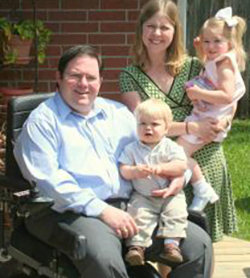THE DYSFERLINOPATHY JOURNEY
Individual Stories
THE DYSFERLINOPATHY JOURNEY
Individual Stories
Home ❯ Patients/Clinicians ❯ The Dysferlinopathy Journey ❯ Individual Stories ❯ Lary
Lary

I was always an active, athletic kid, who loved playing baseball, football, basketball, tennis, and golf. At approximately 13 or 14 years old, I noticed that I could not run as fast as I did in the past. Each year that passed, I quit participating in one more sport due to declining physical ability. By my senior year in high school, only golf remained. My family and I didn’t think there was a medical problem until I could no longer do toe lifts and began experiencing difficulty climbing stairs.
First, I visited my primary doctor, an internist. After performing a visual observation and some manual muscle tests, he referred me to a local neurologist. The local neurologist pretty much did the same thing. Something obviously concerned him though, as he referred me to the chief of neurology at a major hospital in the Texas Medical Center. By then, I was 17.
After an initial visit with the chief neurologist, he suggested that we start doing tests until the cause was identified. (This was my first realization of the process-of-elimination nature of medicine.) I was able to do the testing as an outpatient in the hospital, which allowed me to go home at night. For three days, I arrived at the hospital before 7:00 am, and left after 5:00 pm. I underwent a spinal tap, a muscle biopsy, and an electromyogram (EMG), along with numerous blood tests. Approximately 14 different neurologists observed me or interviewed me. My family and I answered the same questions repeatedly.
One of the doctors proposed a diagnosis of Miyoshi Myopathy, a rare form of muscular dystrophy. After much discussion amongst the doctors, they agreed that this was the correct diagnosis. They informed me that it was a progressive muscle disease about which I could do nothing, but they assured me that it was probably slow-moving, limited to my distal muscles, and that I would have years of enjoying life. They told me it was good that I liked golf, because I would probably be able to play it for a long time.
I played my last round of golf 22 months later. Within five years, I needed a manual wheelchair. Eighteen months after that, I needed a powered wheelchair, as the MD started to impair my upper-body strength. After approximately eight years had passed, I was seriously questioning my diagnosis. My experience wasn’t matching the doctors’ original prognosis or other patients’ experiences.
One day I discovered the Jain Foundation. I couldn’t believe that such a group existed for a disease so rare. After contacting them, they explained the importance of identifying, with 100% surety, patients that had the disease. Since I still worried about the accuracy of my diagnosis, I welcomed the opportunity to get some definitive answers.
The keys to a 100% diagnosis were (1) confirming that I indeed had a dysferlin deficiency and (2) identifying the mutations causing that deficiency. The Jain Foundation walked me through the entire process. First, they advised me which initial blood test to request from my neurologist, and this test confirmed that I was dysferlin deficient. Then they guided me through the more complex step, getting a mutational analysis completed in France. They provided specific instructions covering everything from the type of vials and labeling the lab technicians should use, to how and where to ship the blood to ensure it remained fit for the analysis.
The mutational analysis confirmed that I do have Miyoshi Myopathy / LGMD2B. While this knowledge changes nothing about my condition, I no longer wonder if I’m living with an incorrect diagnosis and missing out on a treatment or cure. Furthermore, the Jain Foundation continues to receive and respond to my questions, always explaining complex science to me in layman’s terms. I am thankful for the peace of mind I have knowing that I’m connected with the world’s foremost experts on this disease.
